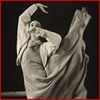
Dance History Teaching Modules
In this section, we collect materials for the study of dance history, as well as introducing some of the processes of historical study. Among the units in this section is Creating American Identities, featuring the works of Martha Graham, Pearl Primus, and Jawole Willa Jo Zollar. In this unit, students investigate ways in which Graham and Primus embraced and questioned American identities during the 1930s and 40s, and how Zollar, a contemporary artist, continues to explore her relationship to heritage and community through dance. Other units examine social dance forms from Latin America as they impact immigrant experience in the United States and powwow as a contemporary performance form and in relationship to Native American history. In addition to exploring specific histories, these units also introduce the practices of historical research, including investigation of primary documents, dance observation and description, movement exploration, and critical analysis. Studying dance history fires the imagination, calling us to re-envision and re-create past dances and to imagine different ways of thinking about and training the dancing body. Studying history is also a means of clarifying issues important to dance in contemporary life: How can I make strategic decisions about representing myself through performance? How is it that people perceive and make meaning from dance? How do other dancers shape and reshape their dance practice and the communities in which they dance and live?

Creating American IdentitiesThis module explores what it means to be an American in the choreography of renowned dance artists Martha Graham, Pearl Primus, and Jawole Willa Jo Zollar. → View Module
|
